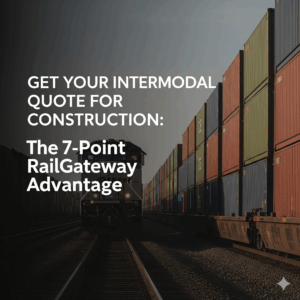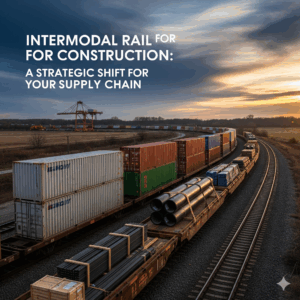In 2025, Canada rail shipping remains a vital cornerstone of the country’s transportation and logistics landscape. As businesses face growing challenges such as supply chain disruptions, rising fuel costs, and increased environmental regulations, rail shipping in Canada is evolving to meet these demands with innovative solutions, enhanced infrastructure, and greater efficiency. This comprehensive guide dives deep into the current state and future outlook of Canada rail shipping—highlighting why it is the preferred freight mode for Canadian businesses looking to optimize cost, sustainability, and reliability in 2025.
The Role of Canada Rail Shipping in 2025
Canada’s expansive geography and economic structure make rail shipping essential. Rail networks link major urban centers, resource hubs, ports, and cross-border gateways with unparalleled capacity and efficiency. The country’s rail infrastructure spans over 46,000 kilometers, making Canada rail shipping indispensable for long-haul freight movement.
In 2025, Canada rail shipping has adapted to technological advancements and changing market needs. Modern rail terminals are equipped with automated container handling systems, real-time tracking, and integrated logistics management platforms. These innovations enhance operational efficiency and provide Canadian businesses with greater control and visibility over their freight.
Why Choose Canada Rail Shipping?
Canadian companies choose Canada rail shipping for a variety of compelling reasons:
- Cost-Effective Freight Transport: Rail is one of the most cost-efficient methods for moving bulk and containerized cargo over long distances. Compared to trucking, Canada rail shipping typically offers lower fuel costs and higher payload capacity per shipment, translating into significant savings.
- Sustainability and Environmental Responsibility: With increased pressure on businesses to reduce carbon emissions, Canada rail shipping is recognized as a greener transportation mode. Rail freight produces up to 75% fewer greenhouse gas emissions per ton-mile than road transport, helping Canadian companies meet sustainability targets.
- Reliability and Capacity: Rail networks provide predictable transit schedules and can handle large volumes of goods, ensuring that Canadian businesses maintain steady supply chains. This is especially critical as truck driver shortages and road congestion continue to impact traditional trucking services.
- Access to Global Markets: Through Canada’s key ports and cross-border rail connections with the United States, Canada rail shipping facilitates seamless international trade. This connectivity supports Canada’s role in global supply chains and export markets.
Key Trends Shaping Canada Rail Shipping in 2025
Several important trends are shaping the future of Canada rail shipping this year:
1. Expansion of Intermodal Rail Shipping
Intermodal rail shipping, which combines rail and truck transport using standardized containers, is growing rapidly in Canada. This hybrid approach leverages rail’s long-haul efficiency and trucks’ flexibility for first- and last-mile delivery. Canadian businesses increasingly adopt intermodal solutions to lower costs, improve sustainability, and enhance supply chain resilience.
2. Technological Innovation and Digitalization
Digital transformation is accelerating in the rail sector. Advanced tracking systems, artificial intelligence for predictive maintenance, and blockchain for transparent freight documentation are becoming standard in Canada rail shipping. These technologies enhance efficiency, reduce delays, and provide greater shipment visibility.
3. Infrastructure Investments and Upgrades
Significant investments in rail infrastructure—such as terminal expansions, double-tracking projects, and improved port connections—are underway across Canada. These upgrades increase capacity, reduce bottlenecks, and enable faster turnaround times for freight, making Canada rail shipping more competitive.
4. Sustainability and Regulatory Pressures
Government policies and industry initiatives focused on reducing transportation emissions place rail shipping at the forefront of sustainable logistics. Incentives for rail freight use and stricter emissions standards for trucking encourage a modal shift toward rail.
Types of Freight Commonly Moved by Canada Rail Shipping
Canada rail shipping supports a wide variety of freight categories, including:
- Bulk Commodities: Coal, grain, minerals, and lumber are transported efficiently by rail, leveraging rail’s ability to move large volumes over long distances.
- Intermodal Containers: Retail goods, manufactured products, and consumer packaged goods are increasingly shipped in containers via intermodal rail shipping, benefiting from container security and ease of transfer.
- Automotive Shipments: Automakers and parts suppliers use rail to transport vehicles and components between manufacturing plants, distribution centers, and dealerships.
- Chemical and Petroleum Products: Specialized railcars transport hazardous materials safely across the country, adhering to strict safety regulations.
Benefits of Using Canada Rail Shipping
The benefits of Canada rail shipping extend beyond cost savings:
- Reduced Road Congestion: Shifting freight from trucks to trains alleviates highway congestion, reducing wear and tear on road infrastructure.
- Improved Safety: Rail shipping has a strong safety record and fewer incidents compared to road freight, making it a secure option for high-value or hazardous goods.
- Enhanced Supply Chain Resilience: Rail’s ability to operate reliably despite weather or labor disruptions adds resilience to Canadian supply chains.
Challenges and Considerations for Canada Rail Shipping
While Canada rail shipping offers many advantages, shippers must navigate some challenges:
- First- and Last-Mile Connectivity: Rail terminals often require trucking for pickup and delivery, necessitating integrated logistics planning.
- Infrastructure Limitations: Certain regions may have limited rail access or capacity constraints, impacting transit times.
- Complexity of Coordination: Managing multi-modal shipments requires expertise in scheduling, container management, and regulatory compliance.
Partnering with experienced rail logistics providers helps Canadian businesses overcome these challenges and maximize the benefits of rail shipping.
How to Optimize Canada Rail Shipping for Your Business in 2025
To make the most of Canada rail shipping, companies should:
- Leverage intermodal options to combine the cost-efficiency of rail with truck flexibility.
- Use advanced logistics software for real-time tracking and data-driven decision making.
- Collaborate with trusted rail carriers and freight forwarders experienced in Canadian regulations and infrastructure.
- Monitor government policies and sustainability incentives that can reduce costs and enhance compliance.
Canada rail shipping is an evolving, dynamic sector in 2025. By understanding its key benefits, trends, and operational best practices, Canadian businesses can design freight strategies that reduce costs, support sustainability, and improve supply chain resilience. Whether moving bulk commodities, containerized goods, or specialized freight, rail remains a foundational pillar of Canada’s logistics success.
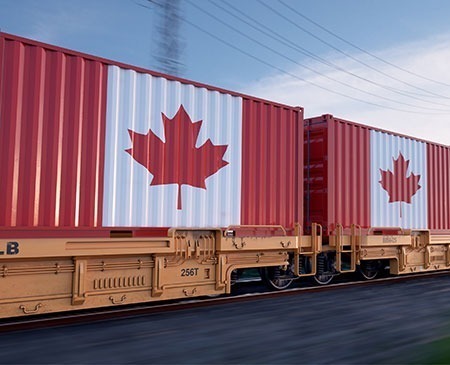
Why Choose Rail Shipping in Canada?
Canada boasts an extensive railway network, stretching from the Atlantic to the Pacific, making it one of the most efficient ways to transport goods over long distances. Rail shipping offers several benefits, including:
1. Cost-Effectiveness
Rail freight is generally more cost-effective than trucking for long distances, reducing fuel costs and increasing transport efficiency. Businesses can save up to 30% on shipping expenses by switching to rail, making it a smart choice for bulk cargo transport.
- Lower operating costs: Rail transport has lower fuel and labor expenses compared to trucking, reducing the cost per kilometer.
- Economies of scale: A single railcar can carry two to three times the cargo of a single truck, spreading fixed costs over larger shipments.
- Long-haul affordability: Rail shipping is especially cost-effective for long-distance shipments, making it an attractive option for cross-country logistics.
2. Environmental Sustainability
Rail shipping produces up to 75% fewer greenhouse gas emissions per ton-mile than trucking, making it one of the most eco-friendly freight options. This reduced carbon footprint helps businesses meet sustainability goals while complying with environmental regulations.
- Reduced carbon footprint: Rail emits significantly less CO₂ per ton-kilometer than trucking.
- Less congestion: Rail shipping helps reduce highway congestion and overall fuel consumption.
- Government incentives: Many companies can qualify for carbon credits or green incentives by shifting freight to rail.
3. Efficiency & Reliability
Rail schedules are typically more predictable than trucking, reducing the risk of delays due to traffic or weather conditions. With dedicated rail corridors and high cargo capacity, businesses can benefit from timely and secure deliveries.
- Higher cargo capacity: Trains can transport large volumes of goods simultaneously, making them ideal for bulk shipping.
- Predictable transit times: Rail schedules are often more consistent than road transport, reducing delays due to weather or traffic congestion.
- Lower accident rates: Statistically, rail has fewer accidents and cargo losses compared to trucking.
4. Intermodal Capabilities
Rail shipping seamlessly integrates with trucking and ocean freight, allowing for door-to-door delivery without the hassle of multiple logistics providers. This flexibility ensures smooth freight movement across different regions and transport modes.
- Seamless integration: Rail works well in combination with trucking (intermodal transportation), allowing for flexible first-mile and last-mile delivery.
- Door-to-door solutions: Many rail freight providers, including RailGateway.ca, offer complete intermodal logistics solutions to streamline the shipping process.
Key Steps to Prepare for Rail Freight Service
Transitioning to rail freight requires strategic planning. Here are the essential steps businesses should follow:
1. Assess Your Cargo for Rail Suitability
Not all cargo is ideal for rail transport. Heavy, bulk commodities such as lumber, grain, and minerals are best suited for rail shipping. However, fragile or high-value items may require additional protection and specialized handling.
- Versatile freight options: Rail can handle diverse shipments, including bulk materials, consumer goods, and temperature-controlled freight.
- Special considerations: Fragile or hazardous materials require compliance with Transport Canada’s rail safety regulations (tc.canada.ca).
2. Evaluate Your Supply Chain & Carrier Options
Choosing the right rail carrier is crucial for cost-effective shipping. Compare service providers based on coverage, transit times, and pricing. Intermodal solutions can help businesses integrate rail with trucking for seamless door-to-door delivery.
- Compare existing carriers: If trucking costs or capacity issues are a concern, explore Canadian rail carriers for a more reliable and cost-effective alternative.
- Work with experts: Companies like RailGateway.ca can help assess your needs and provide custom rail freight solutions.
3. Understand Rail Shipping Costs & Budgeting
Rail freight is generally more economical for long-distance shipments. However, pricing can vary due to fuel surcharges, peak season demand, and route availability. Obtain multiple quotes to ensure competitive pricing and avoid unexpected expenses.
- Factors affecting cost: Freight class, cargo type, distance, and seasonal demand influence rail rates.
- Get accurate quotes: RailGateway.ca provides free, no-obligation quotes to help businesses estimate shipping costs.
- Negotiate contracts: Long-term contracts may offer discounted rates and priority service.
4. Ensure Proper Packaging & Equipment
Proper packaging minimizes the risk of damage during transit. Use durable containers, secure cargo with strapping or bracing, and comply with carrier guidelines. For hazardous materials, additional safety protocols must be followed.
- Container selection: Use proper intermodal containers (20ft, 40ft, or 53ft) based on shipment type.
- Secure packaging: Goods must be secured to withstand vibrations during rail transit.
- Check restrictions: Rail prohibits certain hazardous materials, so compliance with regulations is essential.
5. Prepare Essential Documentation
Accurate documentation is essential for smooth rail freight operations. Ensure you have a bill of lading, customs paperwork, and shipping labels ready. Missing or incorrect documents can lead to costly delays and compliance issues.
- Commercial Invoice: Details cargo type, value, and weight.
- Bill of Lading (BOL): Legally binds the shipment between shipper and carrier.
- Customs Clearance: Required for cross-border shipments between Canada, the U.S., and Mexico.
Disadvantages of Rail Shipping Compared to Other Modes
While Canada rail shipping provides cost savings and environmental benefits, it also has limitations. Understanding these drawbacks can help businesses determine the best shipping method for their needs.
Limited Route Flexibility
Unlike trucking, which can reach virtually any location via roads, rail shipping is confined to fixed railway networks. This can pose challenges for businesses requiring flexible, door-to-door delivery solutions or those with frequent destination changes.
Dependence on Rail Infrastructure
Rail freight relies on well-maintained tracks, terminals, and equipment. Delays due to track maintenance, weather conditions, or labor disruptions can impact shipping schedules and supply chain efficiency.
Terminal Handling & Additional Costs
Unlike direct trucking, rail shipments often require handling at rail terminals, which can increase the risk of cargo damage or loss. Additionally, intermodal transfers between rail and trucks can lead to extra costs and logistical complexities.
First & Last-Mile Delivery Challenges
Many businesses lack direct rail access, necessitating the use of trucking for first-mile pickup and last-mile delivery. This added step can impact overall shipping efficiency and increase transportation costs.
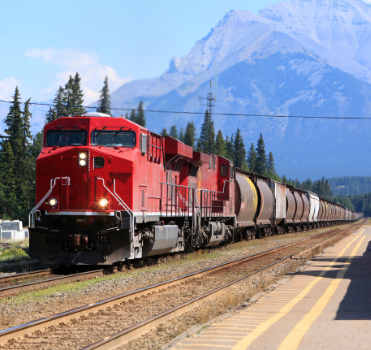
Comparison of Rail Shipping to Other Transportation Modes
To make an informed decision about Canada rail shipping, it’s essential to compare it to other transportation modes, such as trucking and ocean shipping. Each option has its own advantages depending on cargo type, distance, and budget.
| Feature | Rail Shipping | Trucking | Ocean Shipping |
| Cost | More cost-effective for long distances and bulk freight | Can be expensive for long hauls; better for short distances | Lowest cost for large international shipments |
| Speed | Moderate, best for medium to long distances | Fastest for short hauls | Slowest, subject to port congestion & weather delays |
| Capacity | High, capable of carrying large loads | Medium, limited by truck size | Highest, ideal for massive bulk shipments |
| Flexibility | Limited to rail routes, intermodal options are available | High, can reach almost any location | Medium, dependent on ports and inland transport |
| Environmental Impact | Lower emissions per ton-kilometer compared to trucking | Higher emissions and fuel consumption | Highest impact, especially for large cargo ships |
Choosing the Right Mode for Your Business
- Trucking excels in speed and flexibility for short distances but becomes expensive and less efficient for long hauls. It also has a higher environmental impact than rail.
- Rail shipping is a cost-effective alternative for bulk freight and long-distance transportation while offering lower emissions and greater reliability.
- Ocean shipping is the most economical for large international shipments, but it’s slow and subject to delays caused by port congestion and weather.
Recent Developments Impacting Canada Rail Shipping
Canada’s rail industry is evolving with new trade corridors, technological advancements, and labor changes. For instance, the Canada-Mexico-USA rail corridor now connects 20,000 miles of track, enhancing North American trade.
1. Rail Strikes & Labor Shortages
- In August 2024, work stoppages at CN Rail and CPKC caused major disruptions across North America, highlighting the need for alternative logistics strategies (Reuters).
2. Cross-Border Trade & New Rail Networks
- The Canada-Mexico-USA rail corridor, operated by CPKC, now connects the three countries seamlessly with a 20,000-mile network, boosting North American trade opportunities (WSJ).
Get Seamless Intermodal Rail Shipping Service in Canada!
For businesses looking for a hassle-free rail shipping experience, RailGateway is a leading intermodal rail freight provider in Canada. Our services are designed to streamline your logistics by combining the cost-efficiency of rail with the flexibility of trucking.
Why Choose Us?
- Customized Solutions: Whether you’re shipping high-volume bulk freight or specialized cargo, we provide tailored intermodal shipping strategies to meet your needs.
- Competitive Rates: Our strong partnerships with Canada’s top rail carriers ensure you get cost-effective pricing and priority scheduling.
- Real-Time Tracking: Stay updated with live shipment tracking, ensuring visibility from pickup to final delivery.
- End-to-End Support: From documentation assistance to seamless cross-border logistics, our team of experts handles every step of the process.
Get a Free Quote Today! Visit RailGateway and discover how we can optimize your Canada rail shipping strategy.
Concluding Words
The Future of Canada Rail Shipping: Why It’s a Smart Move for Your Business in 2025 and Beyond
As we conclude this comprehensive guide, it’s clear that Canada rail shipping holds a pivotal role in shaping the future of logistics and freight transport across the country in 2025. For businesses operating in Canada, rail shipping is no longer just an option—it’s a strategic advantage that unlocks cost savings, sustainability, scalability, and operational resilience in an increasingly complex transportation environment.
Embracing Cost Efficiency and Reliability with Canada Rail Shipping
With fuel prices and labor costs rising, traditional road freight methods are becoming increasingly expensive and less reliable. Canada rail shipping offers a cost-effective alternative by transporting large volumes of goods efficiently over long distances. This mode of freight reduces overall transportation expenses for Canadian companies by optimizing economies of scale and leveraging the fuel efficiency of trains, which consume far less fuel per ton-mile compared to trucks.
Reliability is another key benefit. Rail networks provide consistent transit schedules and are less affected by traffic congestion or driver shortages. For Canadian businesses competing in tight markets with demanding customers, this reliability translates into fewer delays and improved supply chain predictability.
Environmental Sustainability: A Crucial Benefit of Canada Rail Shipping
Sustainability is no longer a buzzword; it’s a business imperative. Canadian companies face growing pressure from regulators, investors, and consumers to reduce their environmental impact. Here, Canada rail shipping is a clear leader among freight modes. Rail transport generates up to 75% fewer greenhouse gas emissions per ton-mile than trucking. By shifting more freight onto rail, Canadian businesses can significantly reduce their carbon footprint, contributing to national and global climate goals while enhancing their brand reputation.
Many provinces and federal programs support rail freight through incentives and grants, making the sustainability benefits of rail shipping also financially attractive. Using Canada rail shipping aligns your business with these incentives and helps future-proof operations against tightening environmental regulations.
Scalability and Adaptability to Meet Growing Freight Demands
As Canada’s economy grows and trade volumes increase, so does the demand for scalable freight solutions. Canada rail shipping provides unmatched capacity for moving large quantities of goods efficiently. Rail’s ability to scale with demand—whether for bulk commodities, intermodal containers, or specialized freight—makes it an essential component of modern logistics strategies.
Moreover, the rise of intermodal rail shipping allows Canadian businesses to combine rail with trucking for first- and last-mile delivery, creating a flexible and adaptive freight network. This multimodal approach helps companies respond quickly to market changes, seasonal fluctuations, and emerging supply chain disruptions, keeping operations agile and competitive.
Technological Advancements Enhance the Canada Rail Shipping Experience
Technology is revolutionizing Canada rail shipping. From real-time tracking and predictive maintenance to AI-driven route optimization, digital tools provide Canadian businesses with greater visibility, control, and efficiency. These innovations reduce delays, improve asset utilization, and enable data-driven decision-making that enhances overall logistics performance.
As rail terminals adopt automation and blockchain-based documentation, processes become faster, more secure, and more transparent. For Canadian companies, this means smoother freight movement and reduced administrative burdens, making rail shipping easier to manage and integrate with other supply chain components.
Overcoming Challenges Through Strategic Partnerships
While Canada rail shipping offers numerous advantages, implementing rail freight solutions requires navigating complexities such as terminal coordination, customs processes (for cross-border shipments), and first/last-mile trucking logistics. Partnering with experienced rail logistics providers is critical.
Expert providers like RailGateway help Canadian businesses manage these complexities by offering end-to-end intermodal solutions, including container management, customs brokerage, and tailored freight strategies. With their support, companies can seamlessly integrate rail into their supply chains and unlock the full benefits of Canada rail shipping without operational headaches.
The Strategic Role of Canada Rail Shipping in International Trade
Canada’s economy is highly trade-dependent, with the United States, Asia, and Europe as key trading partners. Canada rail shipping facilitates efficient access to global markets by connecting inland production centers with major ports and cross-border gateways. Rail’s interconnectivity ensures freight moves quickly and cost-effectively across borders, helping Canadian exporters and importers remain competitive in global supply chains.
Final Thoughts: Make Canada Rail Shipping Your Logistics Advantage in 2025
In the face of rising costs, environmental demands, and supply chain complexities, Canada rail shipping stands out as the smartest freight solution available to Canadian businesses in 2025. Its cost efficiency, sustainability credentials, scalability, and growing technological sophistication make it a critical element of modern logistics.
Whether you’re shipping bulk commodities, consumer goods, or industrial products, incorporating rail into your freight strategy can deliver measurable benefits—reducing expenses, lowering emissions, increasing reliability, and expanding your market reach.
The time to act is now. By embracing Canada rail shipping today, your business will position itself for sustainable growth and supply chain resilience in the years ahead.
Take Action with RailGateway
Ready to transform your logistics with Canada rail shipping? RailGateway offers comprehensive, customized rail freight solutions tailored to the unique needs of Canadian businesses. From initial consultation and route planning to execution and ongoing support, RailGateway’s experts help you maximize cost savings and efficiency while navigating regulatory and operational complexities.
Visit railgateway.ca to learn more about how Canada rail shipping can elevate your freight strategy and request a free consultation or quote today.
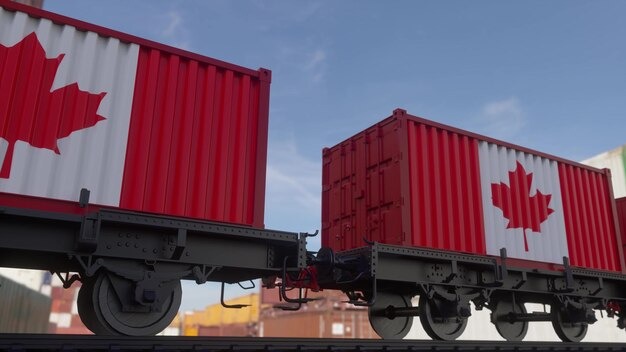
FAQs
How Much Does It Cost to Ship by Rail?
Rail rates are subject to change based on weather conditions and other factors influencing railway efficiency throughout the year. Notably, a single railcar can transport two to three truckloads, leading to significant cost savings.
How Do I Track My Rail Shipment?
Modern tools now provide businesses with detailed tracking capabilities, allowing for real-time monitoring of railcar locations and shipment statuses.
Is Shipping by Rail Cheaper Than by Truck?
While costs depend on equipment and cargo type, train transport is generally more cost-effective than truck transport for long-distance shipments.



